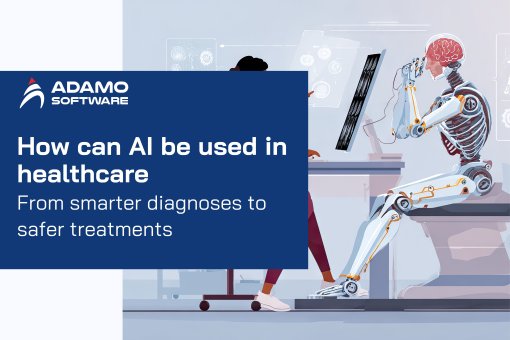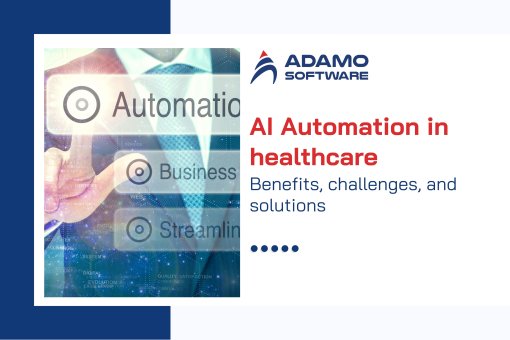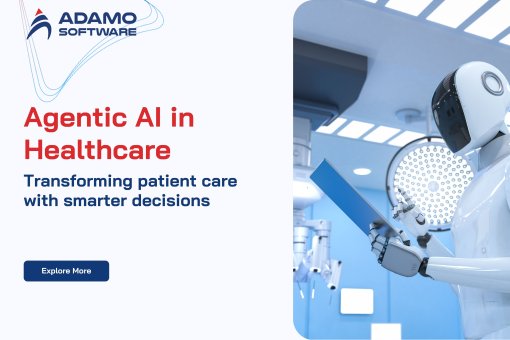Virtual care software development: Market insights and guide for newbie
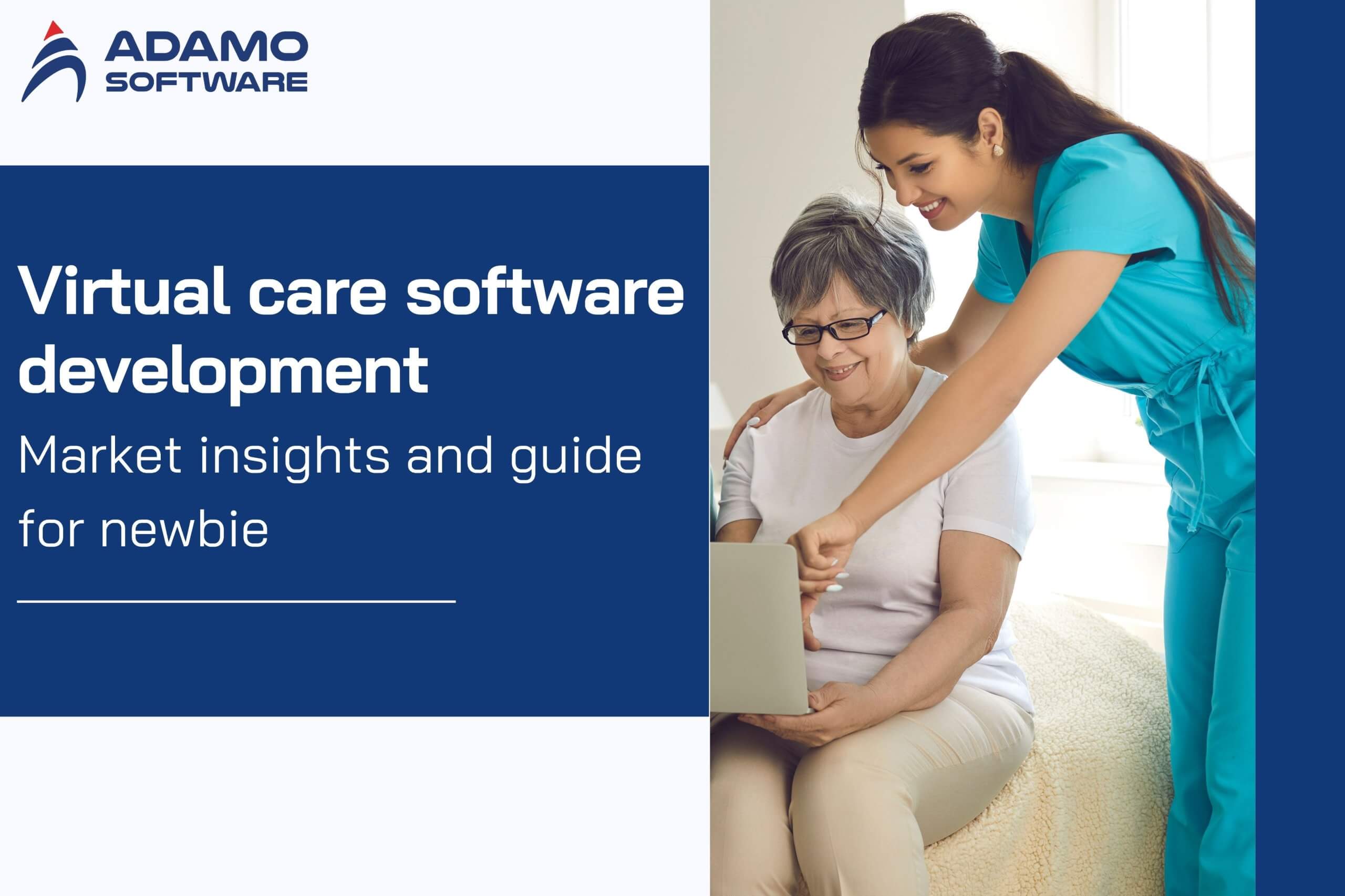
Virtual care software development market is getting more popular. Let Adamo Software introduce some market insights for this sector.
Nowadays, remote medical examinations and treatment at home are in high demand and are truly necessary. Thanks to the software, patients can communicate with doctors without going directly to the hospital. Under this situation, virtual care software development is also getting more popular. The market for this sector is significantly expanding, creating a great opportunity for businesses and software developers.
However, to enter this sector successfully, it is a must to understand the market trends, technical requirements, and important factors for developing the software. Let Adamo Software introduce some market insights for virtual care software development.
Through this blog post, you will have an overall picture of the remote patient monitoring software, the steps to follow to develop the software, and some factors to consider before creating the software. Besides, you will also know some trends to look forward to in developing the software. All of the information has been thoroughly researched and updated to the latest trends. So, let’s read our blog post and find some useful information!
I. Virtual care software development: Market overview
The virtual care software development market has experienced significant growth these years, especially after the COVID-19 pandemic. Since the pandemic, the demand for flexible healthcare solutions that allow patients to be treated remotely has promoted the use of telehealth technologies. In the future, this industry is projected to grow at a high rate, thanks to the popularity of mobile devices, IoT in healthcare, and artificial intelligence (AI).
From 2022 to 2030, this industry is expected to grow at a compound annual growth rate (CAGR) of 32.1%. Accordingly, the global market value for this sector was only USD 8.4 billion in 2022, while this number can be surged to USD 76.9 billion in the next 8 years. In the US alone, the virtual care software development’s market value was around USD 7.1 billion in 2023. In 2032, the market is projected to grow at a CAGR of 29.2%. The market is growing strongly due to rising chronic diseases and technological advancements.
Despite the rapid growth and increasing adoption, the market for virtual care software development faces many challenges. Fierce competition among technology companies requires businesses to constantly innovate to create optimal solutions. In addition, data security and medical regulatory compliance issues also pose significant barriers.
Overall, the virtual care software development market is significantly increasing. By investing in research and development and working closely with medical experts, you can create solutions that meet the growing needs of the market.
II. Step-by-step guide for Virtual Care Software Development
The virtual care software development must follow a strict process to ensure the software’s effectiveness, security, and scalability. Every step plays an important role in creating software that meets the real-life demand. Here is a step-by-step guide to developing a successful telehealth solution.
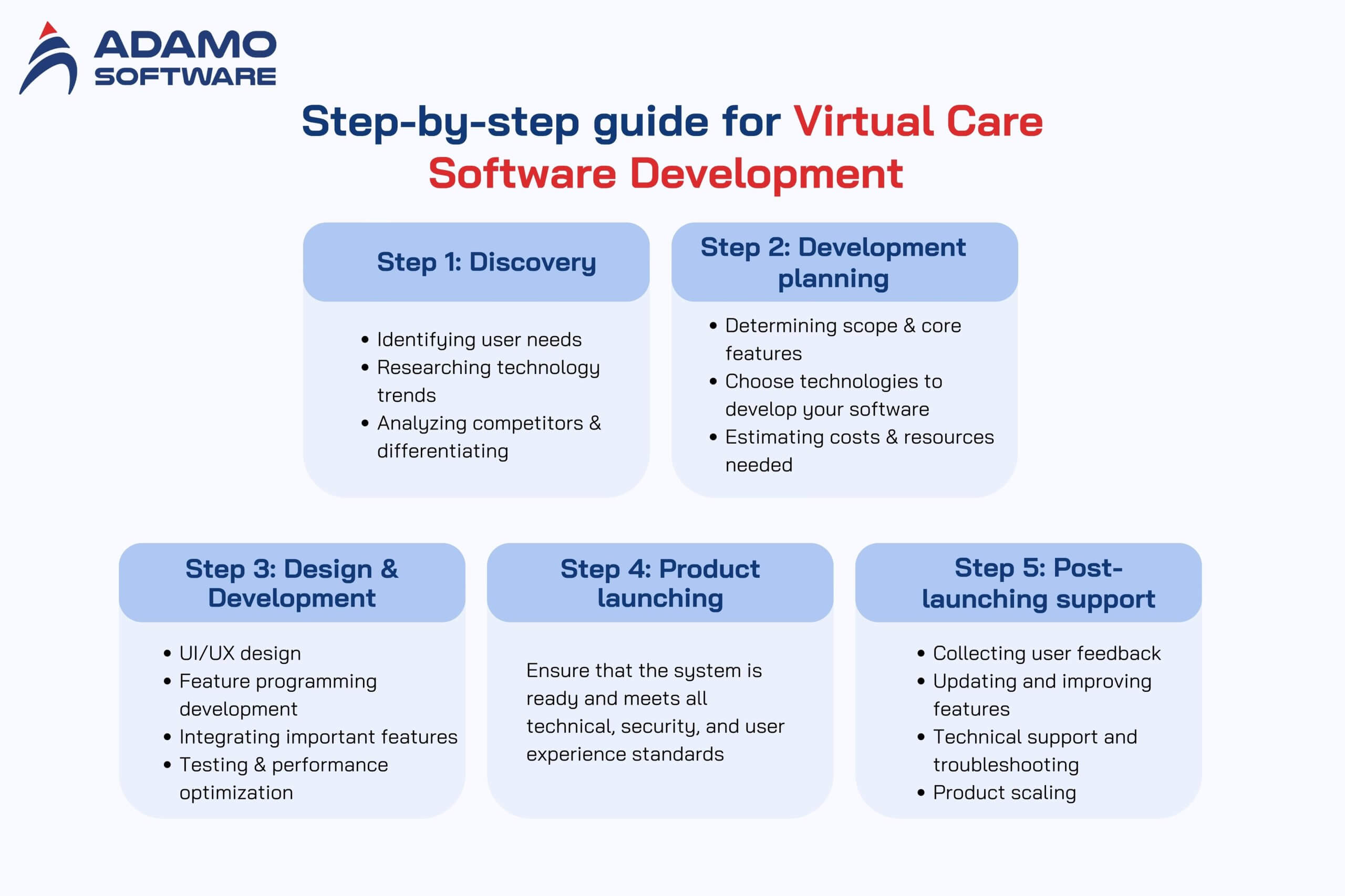
Step 1: Discovery
Discovery is the first step in virtual care software development. Before developing the system, you may want to do market research to identify the needs for using the software, technology trends, professors’ ideas, and current competitors in the market. By carefully researching, you can avoid risks, save costs, and enhance your development’s success.
- Identifying user needs
Your virtual care software development must start by identifying user needs. You may want to know what patients expect from your software and ask them if they need support for appointment scheduling, video consultations, or health record management.
Besides understanding the patients, you must also learn what tools that doctors and healthcare providers need for remote diagnosis and treatment. Let’s see if they need to integrate Electronic Health Records into the software.
- Researching the technology trends
Researching technology trends is also essential for your virtual care software development. You may want to know what technologies are being used most in the healthcare sector. For example, AI, Blockchain, and IoT technologies are becoming popular tools in digital healthcare solutions.
- Analyzing competitors and differentiating
As mentioned, the virtual care software development market is a potential market that has competition from many technology companies. Thus, you must analyze the competitors and identify your points of difference to develop a unique product. Let’s see your competitors’ product features and their difficulties and disadvantages. From the analysis, you can differentiate your software from other software in the market.
Overall, the market research step helps you understand the market and identify how to develop your software. When you have enough data, you can enter the next step of virtual care software development: development planning.
Step 2: Development planning
Development planning is an important step in your virtual care software development. This step helps you identify the roadmap, project scope, technology used and required budget for your project. With a tight plan, you can encourage your development team to work more effectively, minimize risks, and ensure the product is completed on schedule.
- Determining the scope and core features of the software
By clearly defining the scope and core features of the software, you will have an overall view of the software, thereby building a suitable implementation plan. You must know what features are most important in the early stages of your virtual care software development. For example, an online appointment booking system, video consultation, medical record storage, and payment integration are some must-have features of your software. Besides, you may also want to know if your software will be developed for the web, mobile, or both.
- Choosing the technologies to develop your software
Your virtual care software development plan cannot lack choosing the ideal technologies for the system. You must consider which programming languages and frameworks are suitable for your software. For example, you may want to choose React Native or Flutter for cross-platform mobile application development, and Node.js or Python for robust backend.
Besides, for the database and storage, scalable and secure solutions such as PostgreSQL, MongoDB, or Firebase, can be your ideal choices. In addition, cloud infrastructure like AWS, Google Cloud, or Microsoft Azure will help the software operate stably and easily scale with many users. Moreover, you must ensure the system encrypts data, two-factor authentication (2FA), and complies with standards such as HIPAA, and GDPR.
- Estimating costs and resources needed
The costs of your virtual care software development can vary based on the size and complexity of the project. The cost of hiring programmers, security experts, UI/UX designers, testers, etc., is among the factors affecting the overall costs. Besides, infrastructure and technology like cloud storage services, integrated APIs, security tools, etc., and regulatory compliance costs are also worth noting.
Step 3: Design and development
Once you have finished planning, you can come to the next step of your virtual care development: designing and developing. This is the most important step in realizing your idea, starting from building the UI/ UX and then the core system programming.
- User Interface (UI) and User Experience (UX) Design
User Interface (UI) and User Experience (UX) Design help users access and use the software more easily. During your virtual care development process, you must think of an intuitive, simple interface that is supportive to users in all situations, especially for older patients who may find it hard to use modern technology devices.
A clear, easy-to-navigate interface is one of the important principles in designing the UX/ UI. This ensures that doctors and patients can find important features such as scheduling appointments, video calling, and accessing medical records easily. Besides, mobile experience optimization is also essential for users, as they may also access your software from a smartphone instead of the website.
Additionally, your design must be consistent in terms of colors, icons, and typography. You can also add text size adjustment, screen readers, or voice control features to support users with vision or mobility issues. After completing the UI/UX design, you can build wireframes and prototypes to test with real users before moving on to the programming phase.
- Feature programming development
Feature programming development is also an important part of your virtual care software development. This process includes backend development and front-end development. The backend is the part that processes the data and logic of the system. You may want to build an API to connect the user interface and the database and implement a database, using systems such as PostgreSQL, MongoDB, or Firebase to store patient records, medical history, etc.
Besides, integrating security and regulatory compliance, such as data encryption, and two-factor authentication (2FA), and ensuring compliance with standards such as HIPAA (US), and GDPR (Europe), is also needed.
Whereas the front-end end is the display that patients and doctors will directly interact with. You can choose React or Angular for web applications and React Native or Flutter for cross-platform mobile applications. If you want to develop separate applications for each operating system, Swift will be ideal for iOS and Kotlin is suitable for Android.
- Integrating important features
Your virtual care software development cannot be completed without integrating important features into your software. During the development process, you need to focus on core features that help the software operate effectively. Some important features include telehealth video calls, an appointment booking system, EHR/EMR, online payment, and data security.
- Testing and performance optimization
Before officially launching your virtual care software development product, you must test the product to ensure stable operation and no serious errors. Functional testing ensures the key features of your software work effectively while security testing allows you to check if the system has any vulnerabilities that can be attacked, especially with sensitive medical data.
Whereas performance testing evaluates the system’s response speed when multiple users access it at the same time. Last but not least, with user acceptance testing, you can collect feedback from doctors and patients and adjust before the official release.
Overall, the design and development step in your virtual care software development helps your software work effectively and deliver the best user experience. Once the software is ready, you can move on to the next phase of your virtual care software development: Product launch & post-launch support.
Step 4: Product launching
Before officially putting the software into use, you need to ensure that the system is ready and meets all technical, security, and user experience standards. The final testing allows you to test the software on many different devices and environments to detect possible errors. Meanwhile, performance optimization ensures that your system can handle a large number of users without problems.
Besides, you may want to check compliance with security standards such as HIPAA (US), and GDPR (Europe) to avoid legal risks. During launching, you should also create user manuals for doctors, patients, and technical support teams to ensure a smooth implementation process.
Step 5: Post-launching support
Your virtual care software development does not stop at developing and launching the software. The post-launching support is also an essential step for your software development. This step helps you retain users and ensure stable system operation. Below are some activities to conduct during this phase.
- Collecting user feedback
- Updating and improving features
- Technical support and troubleshooting
- Product scaling
Overall, the post-launching step helps the product develop sustainably and meet the increasing needs of users. Once the system is stable and has a certain number of users, you can continue to invest in expansion strategies to enhance its competitive advantage in the market.
Also read: Virtual care platform: What is it, key benefits, and top apps reviewed
III. Factors to consider before creating your custom virtual care software
Before starting your custom virtual care software development, you must thoroughly consider important factors to ensure the efficiency of your software. Let Adamo
Software discusses the three most outstanding factors in developing software, including regulatory compliance and standards, security and safety, and other challenges in virtual care software development.
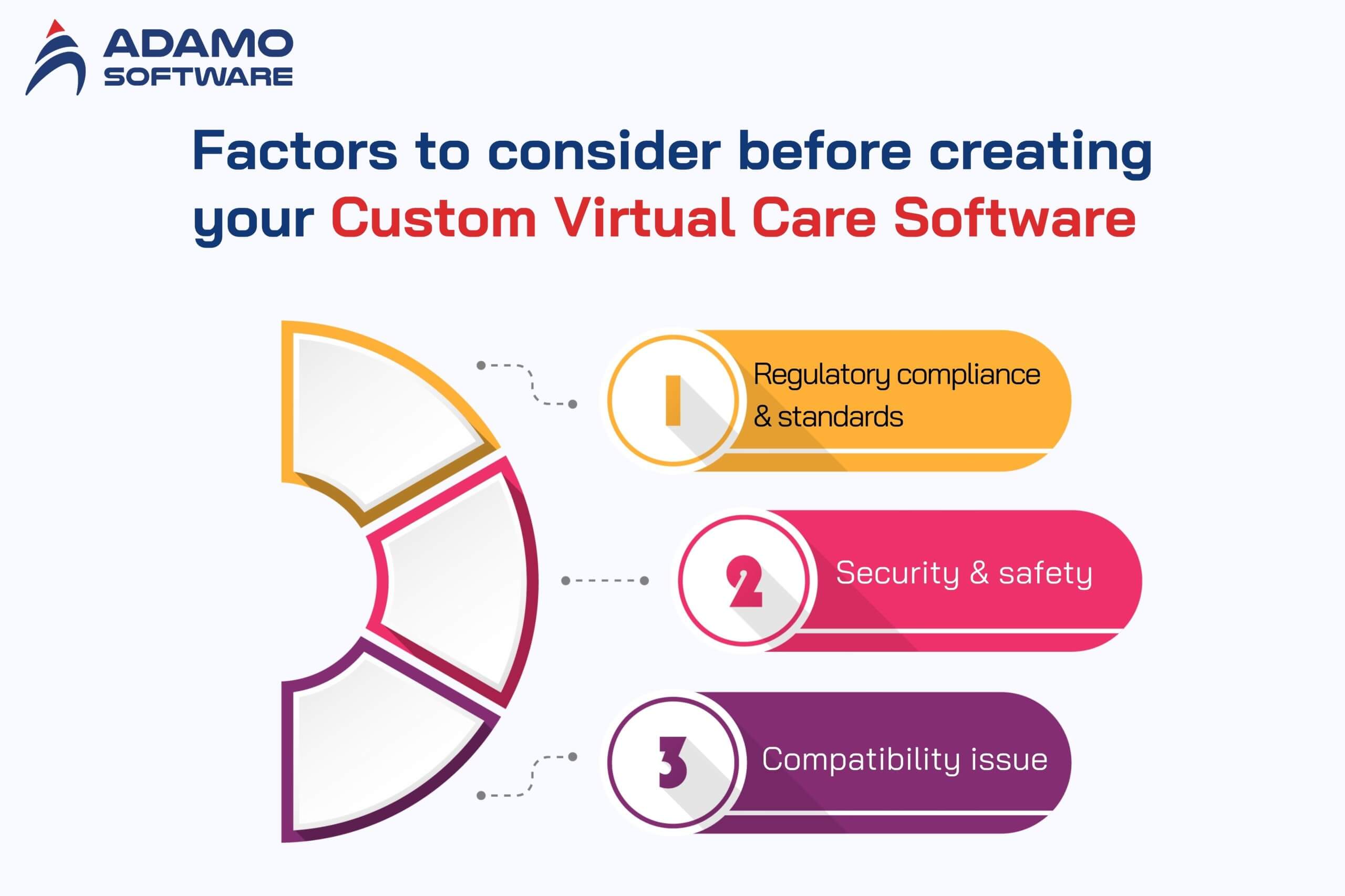
1. Regulatory compliance and standards
Compliance with medical regulations and standards must always be a top priority for virtual care software development. You must consider different countries’ regulations for your virtual care software development. For example, the healthcare software in the US must comply with HIPAA (Health Insurance Portability and Accountability Act) to ensure the confidentiality of personal health information. In Europe, the regulation is GDPR (General Data Protection Regulation), which ensures user personal data protection and management. In addition, if the software integrates electronic medical records (EHR/EMR), you must comply with HL7 and FHIR standards to ensure compatibility with existing medical systems.
2. Security and safety
Security and safety are among the most important factors to consider for your virtual care software development. Data encryption is essential to protect patient information during transmission and storage. Common encryption methods such as AES-256 and TLS 1.2/1.3 help ensure that data is not leaked or stolen by cyber-attacks. Additionally, implementing multi-factor authentication (MFA) also helps reduce the risk of unauthorized access to the system.
In addition to data security, you also need to ensure safety during service delivery. This includes checking the quality of video calls and ensuring stable connections to avoid interruptions during medical consultations. In addition, monitoring and alerting systems need to be deployed to promptly detect suspicious behavior, such as DDoS attacks or unauthorized access from outside.
3. Other challenges in virtual care software development
Besides compliance and security issues, you also face many other challenges when developing telehealth software. Compatibility with multiple devices and operating systems is among these difficulties. Users can access the service from computers, smartphones, tablets, or smart medical devices (wearables), so the software needs to be optimized to work smoothly on many different platforms.
Besides, you may also face challenges in the healthcare facilities’ existing healthcare systems, including electronic medical records (EHR/EMR), hospital management systems (HIS), and health insurance billing systems. However, this integration is often difficult due to differences in data standards, API protocols, and operating procedures of each hospital or healthcare organization. Without a good integration plan, the software may not synchronize patient data, causing disruptions in the diagnosis and treatment process.
In general, virtual care software development requires not only technical expertise but also a clear understanding of regulatory standards, data security, and market challenges. To build a successful product, you need to ensure that the software is fully compliant with healthcare regulations, implement robust security measures, and have a long-term development strategy to compete in the market.
IV. Top trends to look forward to in Virtual Care Software Development
The Virtual Care industry is growing rapidly due to technological advancements and increasing demand from patients and healthcare organizations. To compete, you must stay updated with the latest trends in virtual care software development. Let’s discuss this with Adamo Software!
1. Integrating Artificial Intelligence (AI) and Machine Learning (ML)
Using AI and ML to support diagnosis is getting more popular. Before your virtual care software development, you may want to integrate these technologies into your software. AI algorithms can analyze patient data to support doctors in diagnosing and making treatment decisions faster. For example, AI can detect early signs of cardiovascular disease through heart rate data or analyze medical images to detect cancer earlier than humans.
In addition, chatbots and AI virtual assistants are also being integrated into remote healthcare software to support patients in making appointments, reminding them to take their medications, and providing accurate medical information. This helps reduce the workload for medical professionals while improving the user experience.
2. Adopting Internet of Medical Things (IoMT) technology
The Internet of Medical Things (IoMT) is an important trend that helps improve the ability to monitor patient health remotely. Smart wearable devices such as heart rate monitors, Bluetooth-connected blood pressure monitors, and glucose sensors for diabetic patients can send real-time data to software, helping doctors monitor health status without the patient having to go directly to the hospital. By adopting IoMT, doctors can detect health problems early and support personalized treatment, thereby improving treatment efficiency and reducing medical costs.
3. Blockchain integration in data protection
Blockchain integration in data protection is also a growing trend in virtual care software development. Blockchain is increasingly being used to help protect patient data, ensure transparency, and prevent unauthorized access. With blockchain technology, medical records are encrypted and stored in a decentralized ledger, helping to prevent the risk of data tampering or leakage. In addition, patients can control access to their personal health records, granting access only to doctors or medical institutions when necessary.
V. Contact with Adamo Software for developing successful Virtual Care Software

Do you want to turn your virtual care software development idea into reality? Are you looking for a partner to help you with this? With experience in developing medical software and digital platforms, Adamo Software is a trusted partner to help you build and deploy effective virtual care software solutions. Here’s how we can help you.
- Providing comprehensive telemedicine software development solution
Adamo Software supports you throughout the entire virtual care software development process. This process includes consulting and needs analysis, custom software development, integration with healthcare systems, and security and regulatory compliance.
- Using advanced technology to support digital healthcare solutions
Adamo Software uses leading technologies to deliver a modern remote healthcare experience. These technologies include AI & Machine Learning, Blockchain, IoMT, and mobile and web applications.
- 24/7 maintenance and technical support
Adamo Software can ensure the stability of the custom virtual care software with 24/7 technical support and after-sales service. Upgrades and bug fixes are provided promptly to ensure a continuous and seamless user experience.
Still hestitating whether to choose Adamo Software? Let’s contact us for more detailed information.







